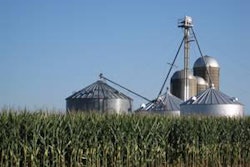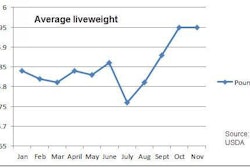The Renewable Fuel Standard is broken, but Congress can fix the rule by acting now and opening an inclusive, robust debate that leads to extensive reform, Dr. Thomas Elam, president of FarmEcon LLC, said at a media briefing on February 4.
Elam presented his remarks on behalf of the National Chicken Council and National Turkey Federation.
Congress in 2005 enacted the first Renewable Fuel Standard which mandated levels of ethanol to be blended with gasoline. In 2007 that ethanol mandate was expanded, and biodiesel was added. The Environmental Protection Agency on January 31 proposed new percentage standards for four fuel categories that are part of the agency’s Renewable Fuel Standard. The proposal is open for a 45-day public comment period, and the agency will consider feedback before the proposal is finalized.
Renewable Fuel Standard challenge for industry
Elam stated that 2007 was a game changer, referring to it as a “Hail Mary.”
“We did not then, and still do not today, have the volume of agricultural raw materials, or the required cellulosic ethanol technology, to meet the 2007 Renewable Fuel Standards goals,” he said. “Nearly six years later, it’s still not a commercial reality. The courts just a few weeks ago ruled this to be the case, as well.”
Corn production has declined while Renewable Fuel Standard mandates have increased, Elam said while discussing the past three years. Smaller supplies have resulted in more than doubling of the most important input cost to poultry production — feed.
“Since Renewable Fuel Standard’s enactment in 2005, annual feed costs for chicken producers have risen $8.8 billion, and turkey by $1.9 billion,” he added. Cumulative additional costs for broilers and turkeys since 2006 total more than $42 billion.
Price increases passed along to consumers
Poultry producers are not the only ones being hit with added costs, though. Elam said these costs are passed on to consumers in the form of higher prices.
“USDA’s average wholesale broiler meat prices leapt from 68 cents in 2005 to a record high 91 cents in December, 2012—a 35 percent increase. Turkey meat soared from 79 cents in 2005 to a record high of 120 cents a few months ago. And it’s not just poultry that costs more. A variety of food products that depend heavily on corn feed are also more expensive. It’s safe to say Renewable Fuel Standards is hitting consumers, poultry producers and farmers squarely in the pocketbook.”
Another unintended consequence from Renewable Fuel Standards is bankruptcy for some. Elam noted that since 2008, eight major poultry producers filed for bankruptcy, and last year, the poultry industry’s contract farmers—this includes many small family farms that raise live birds — lost about $500 million in potential income. “This loss is attributable to chicken and turkey production that did not happen because of higher feed costs,” he explained.
“We need to inject a dose of reality into Renewable Fuel Standards, especially when corn supplies are limited due to historically low inventories,” Elam continued. “Renewable Fuel Standards is a man-made crisis. The 2012 drought was not… As a witness to the devastating impact of Renewable Fuel Standards on the good people who work so hard to feed our country, I say, allow them to compete on a level playing field with fuel ethanol producers who have an unfair advantage thanks to the 2007 Renewable Fuel Standards rule changes.
Another concern Elam shared was that the market for E85 ethanol blends is not as large as some may lead others to believe.
“We’ve had E85 on the market for seven or eight years now, and consumers have not exactly flocked to E85, even though it’s been available. People don’t walk into a dealer buying a new car, saying ‘I’ve got to have a flex-fuel vehicle,’” Elam said. The fact is that ethanol is so expensive compared to gasoline on an energy basis, not a per gallon basis, that E85 is far from economical to put into your car on a cost-per-mile basis because of the reduction you see in your mileage.”
Ethanol exports on the horizon
Elam added that without a feasible market, the U.S. could end up exporting ethanol to other countries, “and I don’t think that was the intent of the law.”
Other groups participating in the media briefing included ActionAid, Taxpayers for Common Sense, American Fuel & Petrochemical Manufacturers, Environmental Working Group and National Marine Manufacturers Association.
Kristin Sundell, who spoke on behalf of ActionAid, said her organization’s biggest concerns about the fuel standards “puts a strain on land and food supplies, contributing to hunger and political instability across the world.”
Developing countries are still feeling the pinch of the U.S. drought and it’s impact on feed supplies, Sundell said, and that problem is magnified by the diversion of more than 40 percent of U.S. corn for ethanol production, in order to meet Renewable Fuel Standard mandates, Sundell added.
Tom Faber, vice president of government affairs for the Environmental Working Group, said ethanol production has hurt the environment, as 23 million acres of grassland and wetlands have been converted for corn production. That is a land mass the size of Indiana, Faber added. That conversion of idle land is driving more carbon to be released into the atmosphere, creating more herbicide and pesticide runoff, and is reducing the amount of available wildlife habitat, he said.
Elam and Steve Ellis, who moderated the media briefing and spoke on behalf of Taxpayers for Common Sense, said they will be participating in congressional briefings February 5 in Washington.
The proposed 2013 overall volumes and standards are: Biomass-based diesel (1.28 billion gallons; 1.12 percent); Advanced biofuels (2.75 billion gallons; 1.60 percent); Cellulosic biofuels (14 million gallons; 0.008 percent); and Total renewable fuels (16.55 billion gallons; 9.63 percent.)


















